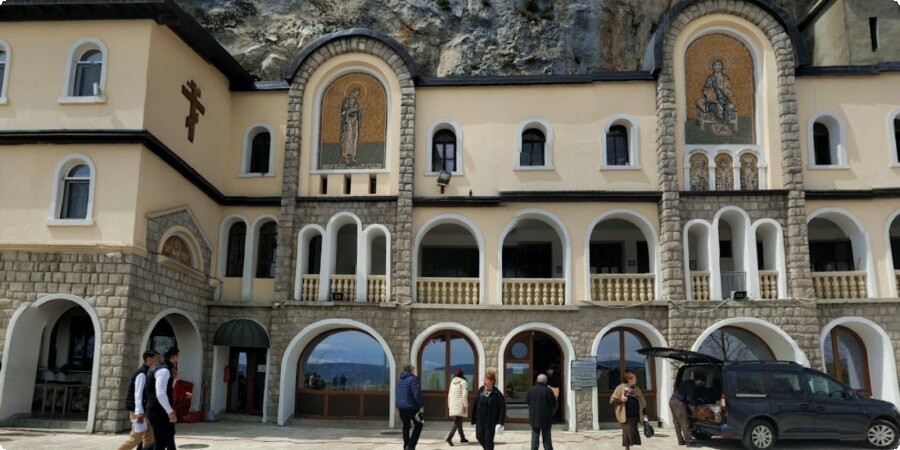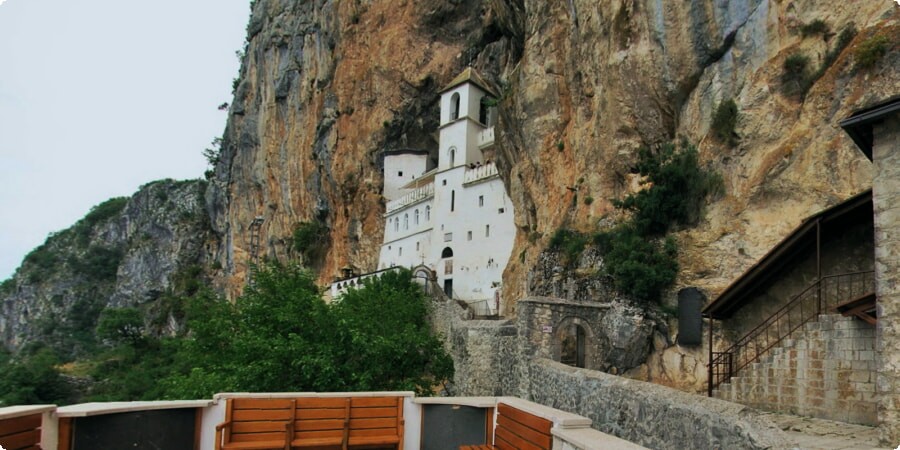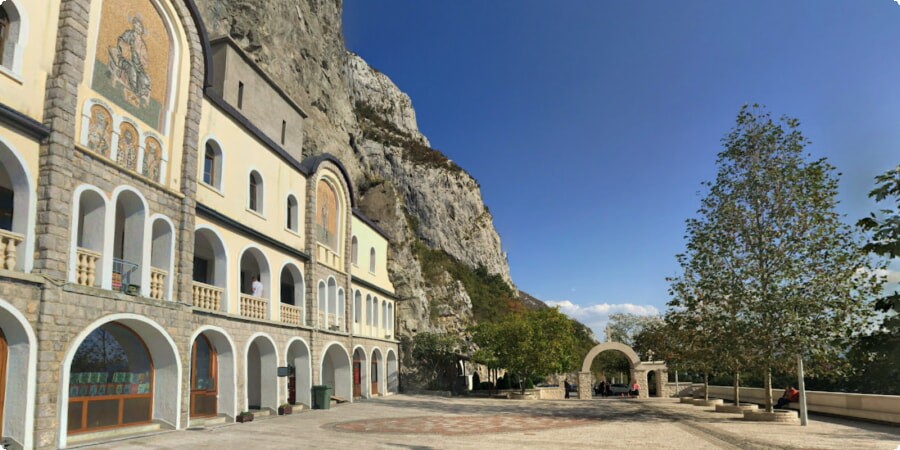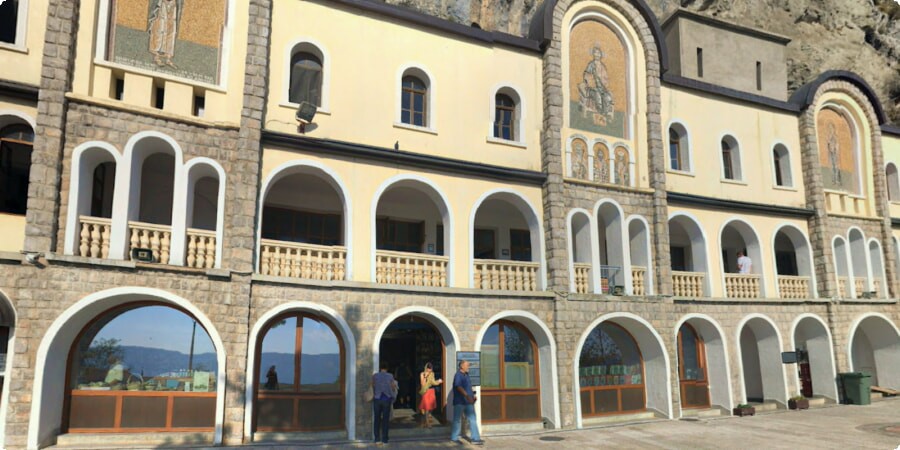Manastir Ostrog: Exploring Montenegro's Most Iconic Monastery
Perched high on the vertical cliffs of Mount Ostrog, Manastir Ostrog is one of Montenegro's most revered and iconic sites. This stunning monastery, dedicated to Saint Basil of Ostrog, attracts hundreds of thousands of visitors and pilgrims each year. Its remarkable location, halfway up a sheer rock face, combined with its rich spiritual and historical significance, makes it a must-visit destination for anyone traveling to Montenegro.
Manastir Ostrog isn't just a place of worship; it's a symbol of faith, endurance, and architectural ingenuity. Built in the 17th century, this monastery has witnessed centuries of history, from the Ottoman Empire's rule to modern-day Montenegro. Today, it stands as a testament to the resilience of faith and the beauty of human craftsmanship, drawing people from all walks of life who seek solace, inspiration, and a connection to something greater than themselves.
Historical Background
The origins of Manastir Ostrog date back to the 17th century, when it was founded by St. Basil of Ostrog, a revered figure in the Eastern Orthodox Church. Born in 1610 in Hercegovina, St. Basil, also known as Vasilije, dedicated his life to his faith, becoming a monk and later a bishop. His deep spirituality and numerous miracles attributed to him during his lifetime made him a beloved figure among the Orthodox faithful.
St. Basil retreated to the remote cliffs of Ostrog to establish a monastery that would serve as a spiritual haven and a symbol of the Christian faith during a tumultuous period of Ottoman rule. He personally oversaw the construction of the monastery, which included two main parts: the Upper Monastery and the Lower Monastery. His efforts created a sanctuary that has withstood the test of time, offering refuge and inspiration to countless believers.
The monastery quickly gained a reputation for being a place of miracles and divine intervention. After St. Basil's death in 1671, his body was entombed in the Upper Monastery, where it remains today. His relics are believed to possess miraculous healing powers, drawing pilgrims from around the world who seek physical and spiritual healing.
Throughout its history, Manastir Ostrog has survived numerous challenges, including attacks and natural disasters. Its resilience has only strengthened its status as a sacred site and a beacon of hope for those who visit.

Architectural Marvels
Manastir Ostrog's architecture is as awe-inspiring as its spiritual legacy. Carved into the face of a towering cliff, the monastery's design is a remarkable feat of engineering and faith. The complex consists of the Upper Monastery (Gornji Manastir) and the Lower Monastery (Donji Manastir), each with its own unique features and significance.
Upper Monastery: The Upper Monastery is the heart of Manastir Ostrog and the most famous part of the complex. It houses the relics of St. Basil in a small, cave-like chapel adorned with frescoes and icons. The chapel's intimate, dimly-lit interior exudes a profound sense of spirituality, with the rock walls adding to the feeling of being in a sacred, ancient place. The Upper Monastery also includes a larger church dedicated to the Holy Cross, where visitors can attend services and light candles.
Lower Monastery: Located about three kilometers below the Upper Monastery, the Lower Monastery serves as the main entrance to the complex. It features the Church of the Holy Trinity, built in the early 19th century. The Lower Monastery is more accessible and provides amenities for visitors, including accommodation for pilgrims, a guesthouse, and facilities for rest and reflection.
The path between the Upper and Lower Monasteries is a pilgrimage route in itself, with many visitors choosing to walk the steep, winding trail as an act of devotion. Along the way, pilgrims encounter stunning views of the Bjelopavlići plain and the surrounding mountains, reinforcing the sense of spiritual journey and connection to the natural world.
Manastir Ostrog's architectural marvels are not just confined to its structures. The monastery's location within the cliffs provides breathtaking panoramas, creating a serene and contemplative environment for visitors. The combination of natural beauty and human artistry makes Manastir Ostrog a unique and unforgettable destination.
To fully experience the wonders of Manastir Ostrog and explore the surrounding region, consider renting a car at Tivat Airport for convenience and flexibility. Book a car here to make your journey seamless and enjoyable.
Manastir Ostrog stands as a testament to the harmonious blend of nature, spirituality, and human endeavor. Its architectural splendor and deep-rooted history offer a profound experience that leaves a lasting impression on all who visit.

Spiritual Significance
Manastir Ostrog holds a profound spiritual significance that resonates deeply with visitors and pilgrims from around the world. As a major pilgrimage site for Orthodox Christians, it is a place where faith, devotion, and tradition come together in a powerful and moving way.
Pilgrimages: Each year, thousands of pilgrims journey to Manastir Ostrog to seek spiritual renewal, healing, and a connection with the divine. Many believe that the relics of St. Basil, enshrined in the Upper Monastery, possess miraculous healing powers. The experience of praying in the presence of these relics, lighting candles, and participating in religious services is profoundly moving for many faithful.
Miracles and Healing: Stories of miracles attributed to St. Basil abound, adding to the monastery's mystique. Accounts of physical healings, answered prayers, and personal transformations are shared among the faithful, further enhancing the monastery's reputation as a place of divine intervention. These miracles are celebrated during the annual feast day of St. Basil on May 12th, which sees a surge of visitors from across the globe.
Religious Services: Manastir Ostrog remains an active monastery with regular religious services, including Divine Liturgy, vespers, and prayer services. Visitors can participate in these services, which are conducted in the traditional Orthodox manner, offering a glimpse into the rich liturgical practices of the Eastern Orthodox Church.
For those seeking a deeper spiritual experience, the atmosphere of Manastir Ostrog, coupled with its history of miracles, offers a unique opportunity to explore faith and spirituality in a setting imbued with centuries of devotion and reverence.

Visitor Experience
Visiting Manastir Ostrog is an enriching experience that combines spirituality, history, and stunning natural beauty. To make the most of your visit, here are some practical tips and insights:
Getting There: The monastery is located approximately 50 kilometers from Podgorica, Montenegro's capital, and about 150 kilometers from the coastal city of Kotor. The journey involves a scenic drive through the Montenegrin countryside, culminating in a steep, winding road that leads up to the monastery. Public transportation options are limited, so renting a car is highly recommended for convenience and flexibility. Book a car in Montenegro to ensure a smooth and enjoyable trip.
What to Expect: Upon arrival, visitors typically start at the Lower Monastery, which houses essential facilities such as restrooms, a small shop, and a guesthouse for pilgrims. From there, a 3-kilometer hike or a short drive takes you to the Upper Monastery. The path is steep and can be challenging, but the effort is well worth it for the panoramic views and the spiritual experience that awaits.
Dress Code and Conduct: As a place of worship, Manastir Ostrog requires visitors to dress modestly. Shoulders and knees should be covered, and hats should be removed upon entering the chapels. Photography inside the chapels is generally not allowed, so be respectful of the sanctity of the space and follow any posted guidelines or instructions from the monks.
Accommodation: For those wishing to spend more time at the monastery, the guesthouse at the Lower Monastery offers simple, clean accommodations. It is advisable to book in advance, especially during peak pilgrimage times. Alternatively, nearby towns like Nikšić offer a range of lodging options, from hotels to private guesthouses.
Nearby Amenities: While the monastery itself provides basic amenities, visitors can find more extensive services, including restaurants and shops, in the nearby town of Nikšić. This town also offers additional cultural and historical attractions for those looking to extend their stay in the region.
By planning ahead and respecting the customs and traditions of Manastir Ostrog, visitors can ensure a meaningful and memorable experience at this sacred site.

Exploring the Surroundings
While Manastir Ostrog is a destination in itself, the surrounding region offers additional attractions and natural beauty that complement a visit to the monastery. Here are some highlights:
Natural Beauty: The area around Manastir Ostrog is characterized by rugged mountains, lush forests, and breathtaking vistas. Outdoor enthusiasts can enjoy hiking, bird-watching, and photography in this pristine environment. The panoramic views from the monastery itself provide stunning photo opportunities, with the Bjelopavlići plain stretching out below.
Hiking Trails: For those who enjoy hiking, several trails in the vicinity offer varying levels of difficulty. The path between the Upper and Lower Monasteries is a popular route, providing not only a spiritual journey but also a chance to immerse yourself in the natural beauty of the region. More adventurous hikers might explore further into the surrounding mountains for a more challenging experience.
Nearby Attractions:
- Nikšić: The nearby town of Nikšić is worth a visit for its historical and cultural attractions. Highlights include the Bedem Fortress, King Nikola’s Palace, and the Cathedral of Saint Basil of Ostrog. The town’s cafes and restaurants offer a taste of local cuisine and a chance to relax after your visit to the monastery.
- Lake Slano: Located a short drive from Manastir Ostrog, Lake Slano is a serene and picturesque spot ideal for a peaceful retreat. The lake offers opportunities for swimming, fishing, and picnicking in a tranquil setting.
Cultural Experiences: Engaging with the local culture can enrich your visit to Manastir Ostrog. Consider attending local festivals or events, sampling traditional Montenegrin dishes, or exploring local markets and crafts. These experiences provide deeper insights into the region's heritage and way of life.
By extending your exploration beyond the monastery, you can fully appreciate the natural and cultural richness of the area, making your trip to Manastir Ostrog a comprehensive and fulfilling experience.
Travel Tips and Practical Information
Planning a visit to Manastir Ostrog requires some practical preparation to ensure a smooth and enjoyable experience. Here are essential travel tips and practical information to help you make the most of your pilgrimage:
Best Time to Visit: The monastery is open year-round, but the best time to visit is during the spring and early autumn months (April to June and September to October). The weather is mild and pleasant, and the trails are accessible without the intense summer heat or winter snow. Visiting during religious holidays, such as the feast day of St. Basil on May 12th, can offer a unique spiritual experience, though it will be more crowded.
Transportation: Reaching Manastir Ostrog is easiest by car, as public transportation options are limited. If you’re flying into Montenegro, consider renting a car for flexibility and convenience. The drive from major cities like Podgorica or Tivat offers stunning scenery but includes steep and winding roads near the monastery. Book a car in Montenegro to ensure a smooth journey.
Accommodation: For those planning to stay overnight, the guesthouse at the Lower Monastery offers basic but comfortable accommodations. It’s advisable to book in advance, especially during peak pilgrimage periods. Alternatively, the nearby town of Nikšić offers a range of lodging options, from hotels to private guesthouses, providing more amenities and dining options.
What to Pack: Dress modestly to respect the monastery’s customs—ensure shoulders and knees are covered. Comfortable walking shoes are essential, especially if you plan to hike between the Upper and Lower Monasteries. Don’t forget essentials like water, snacks, and a first-aid kit, as the steep path can be challenging.
Etiquette and Conduct: As a place of worship, it’s important to maintain a respectful demeanor. Avoid loud conversations, and follow any posted guidelines or instructions from the monks. Photography inside the chapels is generally prohibited, so be mindful of the sanctity of the space.
With these tips in mind, you can ensure a respectful, enriching, and memorable visit to Manastir Ostrog.
Seasonal Splendor: Manastir Ostrog Through the Seasons
Manastir Ostrog’s beauty and atmosphere change with the seasons, each offering a unique experience for visitors:
Spring (April to June): Spring is a vibrant time at Manastir Ostrog, with blooming wildflowers and lush greenery enhancing the scenic beauty. The mild weather makes it ideal for hiking and exploring the monastery grounds. This season is less crowded than summer, providing a more peaceful and reflective visit.
Summer (July to August): Summer is the peak tourist season, attracting visitors with warm weather and long days. The monastery can be quite crowded, especially during weekends and religious holidays. The hike between the Upper and Lower Monasteries is more strenuous in the summer heat, so early morning or late afternoon visits are recommended. Despite the crowds, the lively atmosphere and various festivals make summer a vibrant time to visit.
Autumn (September to November): Autumn brings a serene and picturesque quality to Manastir Ostrog. The surrounding forests transform into a tapestry of red, orange, and gold, creating a stunning backdrop. The cooler temperatures are perfect for hiking, and the trails are less crowded. This season is ideal for photography enthusiasts and those seeking a quieter, more contemplative visit.
Winter (December to March): Winter at Manastir Ostrog is a time of quiet reflection. Snow blankets the mountains, creating a magical and tranquil setting. The monastery is less visited during this time, offering a peaceful experience. However, the steep roads and paths can be challenging due to ice and snow, so caution is necessary. Winter is also a time to experience the monastery’s warm hospitality, as the monks welcome visitors seeking solace and spiritual renewal.
No matter the season, Manastir Ostrog offers a unique and enriching experience, allowing visitors to connect with its spiritual heritage and natural beauty.
Manastir Ostrog, with its awe-inspiring architecture, deep spiritual significance, and breathtaking natural surroundings, stands as a testament to the enduring power of faith and human ingenuity. From the miraculous relics of St. Basil to the serene paths between the Upper and Lower Monasteries, every aspect of this sacred site invites reflection, inspiration, and a profound connection to something greater.
Whether you're making a pilgrimage, exploring Montenegro's cultural heritage, or simply seeking a place of peace and beauty, Manastir Ostrog offers an experience that touches the heart and soul. As you plan your visit, remember to approach this sacred space with respect and openness, ready to embrace the adventure and spiritual enrichment it promises.
Your journey to Manastir Ostrog is not just a trip to a historic site; it's a passage through time, faith, and the stunning landscapes of Montenegro, leaving you with memories and insights that will last a lifetime.